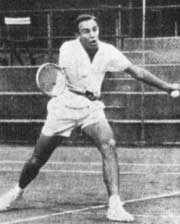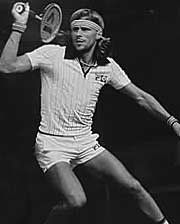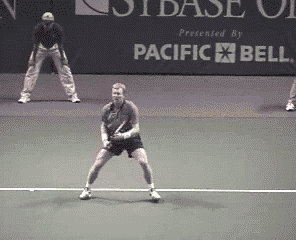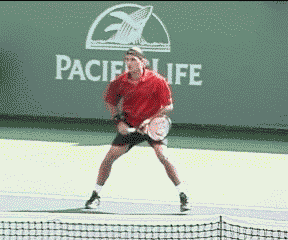|
TennisOne Lessons Court Positioning Jim McLennan David Ferrer and Rafael Nadal delivered a breathtaking performance the other night, with both players scrambling across every inch of the court and trading thunderous topspin forehands (mostly). And though certainly they finished many points at the net, the overwhelming impression was of both players favoring forehands over court position, and then scrambling to recover again and again. Could either of these guys sustain this style of play for a few years? To my eye they play winning yet equally dangerous tennis. Too much pounding. Too much effort. Overuse injuries lurking in the background.
As these open stance semi-western forehands litter the professional landscape, playing styles have evolved where many if not most players now routinely patrol the baseline. Net play, approach shots, and even volleying skills are much less evident (yes, there are some exceptions), the guys and gals generally prefer rallying the ball back and forth. In fact, in many instances, the points appear remarkably similar to practice sessions where players simply keep the ball in play for ten, twenty and even thirty hits at a clip. John McEnroe, Mary Carrillo and a few other commentators continue to decry the lost opportunities when a man or woman fails to move forward, sacrifice court position for risky forehands from the backhand alley, fail to seize the opportunity on the short ball, and or fail to convert at the net. They question the passive court positioning, if not the risk that accrues from the extreme movement required to move well into the backhand alley to drive yet another semi-western forehand. But, Mac played with continental grips, took the ball early, always looked to move forward, and importantly his opponents used far less topspin and power than we see in the “modern” game. Yes the game is now changed, and semi-western topspin appears to rule the day – until Federer steps up with eastern forehand and backhand grips and the total facility to move inside the baseline. And it just may be that a part of his success derives from the sameness of the baseline opponents he faces day in and day out. The big topspin forehand has been around for many years. In the 70’s John Newcombe’s “buggy whip" (named by our good friend Bud Collins) and Tom Okker’s massive forehand may have been precursors of today strokes. Both guys started the swing high, both swooped beneath and then sharply up against the ball, and both were prone to run around the occasional backhand if the forehand opportunity occurred. Borg followed with more of a semi-western version of this stroke, deadly consistent, but he played with an equally deadly backhand so there was no need to sacrifice court position to avoid the backhand.
Lendl came next, where the topspin forehand became a huge weapon, and he rode this stroke to many Grand Slam titles. Interestingly he trusted his backhand chip and was content to rally from that side until he finally got the big forehand. He was more likely to run around the backhand when finishing points rather than rallying, and it was McEnroe who noted the near impossibility of getting his return of serve away from the Lendl weapon. Courier and Agassi (the early version) took this forehand strategy one step further, moving often into the backhand corner to drive the forehand. Both moved quite well, neither really favored playing at the net, both used versions of the semi-western grip, and this style has now been imprinted on the next generation of junior “bangers.” The outcome of this trend, however, has been a group of players with far less fluency at the net, as well as a group of players with far less feel for the game of doubles.
Tactical Considerations So I believe there are a number of practical “take-aways” (in the form of scenarios) for you and I when it comes to court positioning. The key tactical component of anyone’s tennis game is to play the ball deep to the opponent’s court. And this depth gives the opponent less opportunities to attack, because when pushed deep you will have more time to react and they will have less angle to explore. Conversely if and when they move forward you will have less time and they can run you by playing the ball to ever wider angles. But, as regards playing a well versed game, the decisions you make concern the depth of the opponent’s shot as well as their court positioning. Simply stated, if your opponent plays the ball deep and you are in position, then you must rally. If your opponent plays the ball deep but you are out of position you must decide whether to play the ball to the open court and with how much speed. If your opponent plays the ball short, then you have the opportunity to move forward and make something happen. But the trick lies in the recognition of these variables, the resulting split second decision, and then the tools to execute the plan.
Scenario One – Opponent in position and plays the ball deep to your forehand or backhand corner. In this instance defense rules the day, little or no reason to run around the backhand, but whenever possible an open stance will simplify your recovery movements. Nikolay Davydenko is as good as it gets for this style. Heavy topspin off both sides, trusting and therefore not avoiding the backhand, and many if not most balls struck with an open stance, which again favors recovery rather than forward movements. Lleyton Hewitt plays a similar open stance semi-western style, and has regrettably commented that he is now working on his approach and net game at a rather late stage in his career. Where was a coach to have shown him this as a teenager? Same could be asked of a coach who worked with a teenage Andy Roddick. Scenario Two – Opponent out of position and plays the ball relatively deep to your backhand side, but importantly not to the backhand corner. In this instance, one can certainly move around the backhand to drive the forehand, but only to drive the ball into the open court, and only if one does not move into or even beyond the alley. Federer plays his forehand from this part of the court, but only when he can take control of the point. On the other hand, Blake and Roddick often move into or beyond the alley, sometimes when the opponent is well positioned, and in these instances they either lose control of the point or make telling errors because they must truly thread the needle from such awkward positions. So for you and me, the choice to play the forehand occurs when the opponent is somewhat out of position and their shot not totally deep nor placed well into your backhand corner. Scenario Three – Opponent plays the ball short. If the opponent is out of position, then you must step forward, take time away and play the ball heavily into the open court. If the opponent is in position, then you must move forward, take the ball on the rise, and approach down the line. I am dumbfounded about how often modern players, particularly Roddick, approach crosscourt, for the volleyer rarely achieves good volleying position when following the crosscourt approach. But now the trick lies in flattening the stroke with more of an eastern rather than semi-western forehand grip. Final Note: Arc of Ball and Path of Swing Consider the arc of a ball after the bounce – initially it rises, then flattens out at the top of the bounce, and finally descends. Now consider the path of the swing, underspin strokes move high to low, flat strokes are essentially level swings at the ball, topspin strokes move low to high, and vicious semi-western topspin strokes move sharply low to high imparting extra spin. Well from the recreational point of view, and Pancho Segura has spoken at length on this topic, players find it quite difficult to play semi-western topspin when playing the ball on the rise.
The timing of this shot is far easier when playing the ball on the descent. But when taking the ball on the rise (because after all you were moving forward to approach down the line), the eastern forehand of Sampras or Federer did this job much more simply than any wicked semi-western model. Further, because you are moving to and then through this ball on the way to the net, one must step in and then through the ball, which is the opposite of the open stance. Picture Sampras or Federer moving forward on this shot with an eastern forehand grip and footwork that carried them to the net. Now get back on the practice court to develop your own “coming in shot.” With the new racquet technology and superbly conditioned athletes, there will always be big forehands struck from the backhand corner. And certainly, we see more and more of this “one note” tennis. But equally, this will create many opportunities for all-court players who have the skills to run around some but not all backhands, who can employ open stance semi-western forehands when rallying, but who can move forward like truly all the great champions have done and will continue to do. Sampras moved forward. Federer moves forward. Enough said. Your comments are welcome. Let us know what you think about Jim McLennan's article by emailing us here at TennisOne.
|
|||||||||||||






